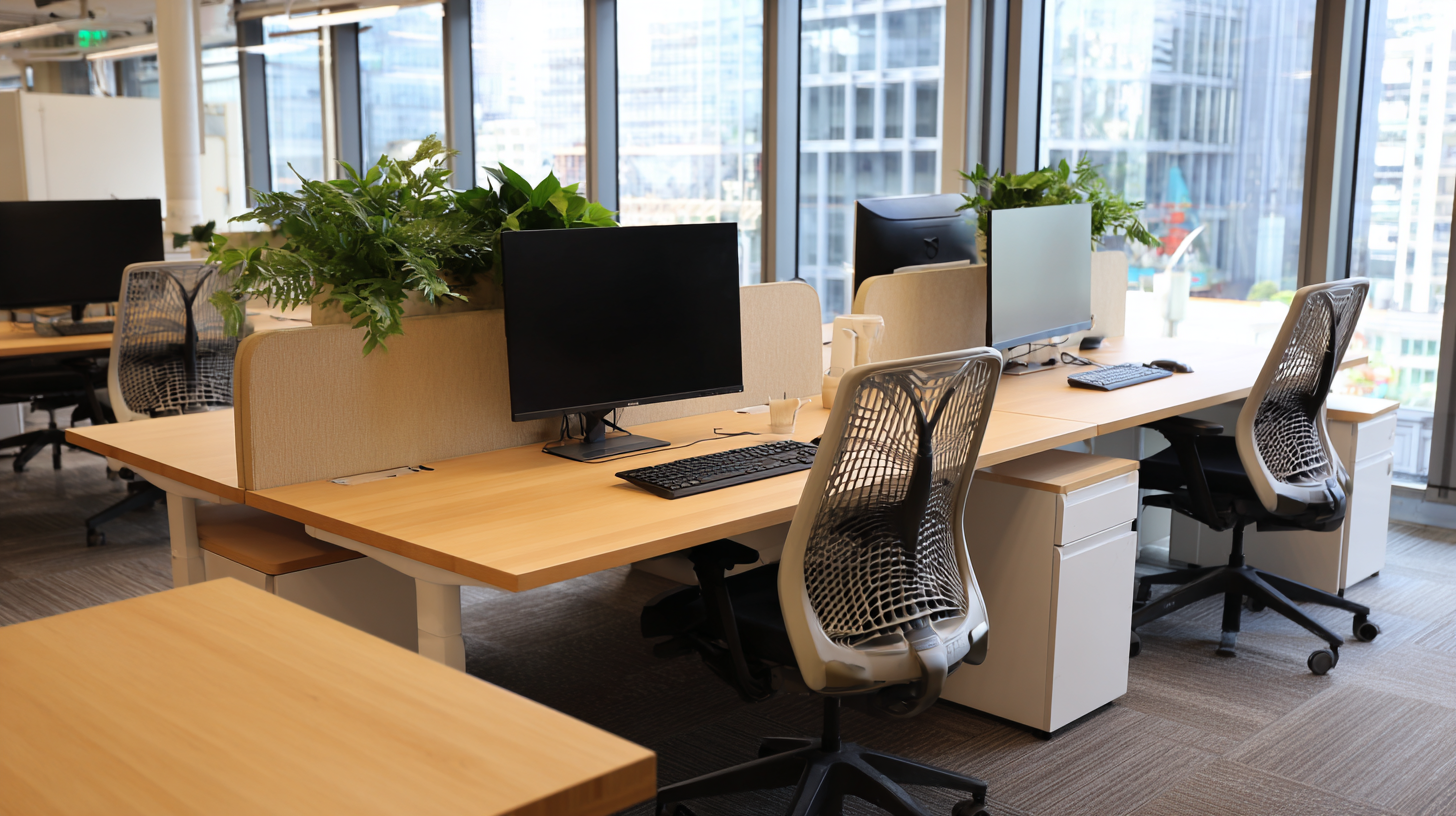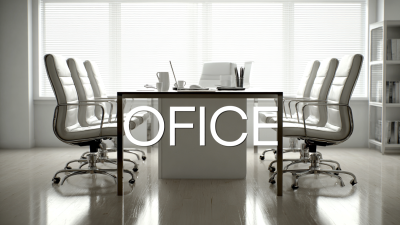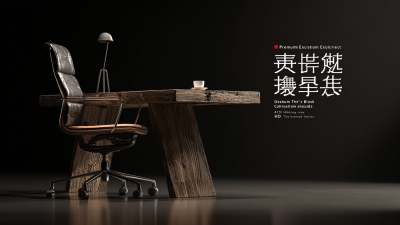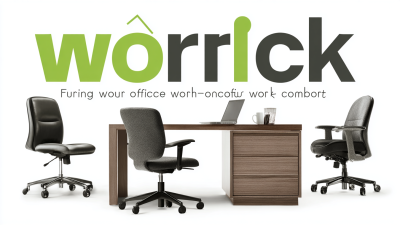Largest Selection of New and Used Office Furniture! Call 1-855-885-3375 or visit a showroom today!
Blog
Elevate Your Workspace: The Impact of Ergonomic Office Desks and Chairs on Productivity and Health
In today's fast-paced work environment, the design and functionality of office spaces play a crucial role in determining employee productivity and overall health. Among the various elements that contribute to an effective workspace, the choice of office desks and chairs stands out as particularly significant. Ergonomic office desks and chairs are designed to accommodate the natural posture of the body, reducing strain and discomfort often associated with long hours of sitting. This can lead to lower absenteeism rates and enhanced concentration, ultimately fostering a more dynamic and efficient work culture. By prioritizing ergonomic solutions in the workplace, organizations can not only improve the well-being of their employees but also enhance productivity, creating a supportive environment that promotes both health and efficiency. In this article, we will explore the profound impact that properly designed office desks and chairs can have on your workspace, offering insights and tips on how to create the ideal setup for success.

The Importance of Ergonomics in Modern Workspaces: Enhancing Comfort and Efficiency
In today’s fast-paced work environment, the significance of ergonomics in modern workspaces cannot be overstated. A comprehensive study by the Occupational Safety and Health Administration (OSHA) reveals that ergonomic improvements can lead to a 25% reduction in workplace injuries. This statistic underscores the critical role that well-designed office furniture plays in promoting comfort and productivity among employees. By reducing strain and discomfort, ergonomic office desks and chairs facilitate a healthier work environment, enabling workers to focus on their tasks without the distraction of physical pain.
Moreover, research from the University of California shows that an ergonomic workspace can boost productivity by as much as 15%. Ergonomically optimized furniture encourages better posture and reduces fatigue, which can significantly enhance overall work output. With employees spending an average of 6-8 hours a day at their desks, the importance of investing in quality ergonomic solutions becomes evident. By prioritizing comfort and efficiency through ergonomic office designs, businesses not only support the health of their workforce but also foster an atmosphere of increased efficiency and output.

Statistics on Work-Related Musculoskeletal Disorders: Understanding the Risks
Work-related musculoskeletal disorders (WMSDs) present a significant health risk in modern workplaces, affecting millions of employees globally. Statistics show that an alarming number of office workers experience discomfort or pain due to poor ergonomics, leading to a higher likelihood of developing chronic conditions. According to recent studies, nearly 60% of workers report ailments related to their posture at work, with issues like back pain and repetitive strain injuries being the most common. This highlights the urgent need for workplaces to prioritize ergonomic solutions, such as adjustable desks and supportive chairs.
Understanding the risks associated with WMSDs is crucial for employers aiming to enhance employee well-being and productivity. The cost associated with these disorders extends beyond individual discomfort; they contribute to increased absenteeism, reduced efficiency, and higher healthcare expenses. Implementing ergonomic furniture and workspace design can significantly mitigate these risks. Research indicates that employees utilizing ergonomic office equipment experience fewer health complaints and report improved concentration and morale. By investing in ergonomics, companies not only safeguard their workers' health but also foster a more productive and engaged workforce.
Impact of Ergonomic Office Equipment on Productivity and Health
This chart illustrates the correlation between the use of ergonomic office desks and chairs and the reduction in work-related musculoskeletal disorders (MSDs). The data reflects the percentage of office workers reporting discomfort before and after the adoption of ergonomic solutions.
Impact of Ergonomic Desks and Chairs on Employee Productivity: A Data-Driven Approach
The integration of ergonomic desks and chairs in the workplace has showcased a significant influence on employee productivity, a claim supported by various data-driven studies. Research indicates that ergonomic furniture leads to reduced discomfort and musculoskeletal issues among workers, which in turn allows for greater concentration and efficiency. For instance, companies that have adopted ergonomic solutions report a notable decrease in absenteeism due to health-related reasons, suggesting that when employees feel comfortable in their work environment, they are less likely to take time off.
Furthermore, a data analysis on employee performance metrics reveals that those utilizing ergonomic setups tend to achieve higher output levels. The improved posture and reduced strain from ergonomic desks and chairs not only enhance physical well-being but also foster a mental environment conducive to sustained focus and creativity. With these findings in hand, investing in ergonomic office furniture emerges as a strategic decision for organizations aiming to boost overall productivity while also promoting a healthier work culture.
Elevate Your Workspace: The Impact of Ergonomic Office Desks and Chairs on Productivity and Health
| Furniture Type | Average Productivity Increase (%) | Health Improvement (%) | Employee Satisfaction Rating (1-10) |
|---|---|---|---|
| Ergonomic Desk | 15 | 20 | 9 |
| Ergonomic Chair | 10 | 25 | 8 |
| Height-Adjustable Desk | 18 | 30 | 9 |
| Standing Desk | 12 | 22 | 8 |
| Conference Room Ergonomics | 14 | 24 | 7 |
Long-Term Health Benefits of Ergonomic Office Furniture: Evidence from Recent Studies
Recent studies have increasingly shed light on the long-term health benefits of ergonomic office furniture, particularly desks and chairs designed to support proper posture and reduce strain. Research demonstrates that individuals using ergonomic setups experience a significant decrease in musculoskeletal disorders, including lower back pain and neck strain. These ailments are often exacerbated by poor seating and desk arrangements, which can lead to decreased productivity and increased absenteeism. By investing in ergonomic office furniture, companies not only foster a healthier workplace environment but also empower their employees to perform at their best.
Furthermore, the psychological benefits of ergonomic furniture cannot be overlooked. A well-designed workspace contributes to higher job satisfaction and morale, as employees feel more comfortable and less fatigued throughout the day. Studies suggest that workers utilizing these ergonomic solutions report improved focus and creativity, reducing distractions caused by discomfort. As organizations prioritize employee well-being, incorporating ergonomic office desks and chairs proves to be a strategic move that has lasting repercussions on both health and productivity.
Cost-Benefit Analysis: Investing in Ergonomic Solutions for Businesses and Employees
Investing in ergonomic office furniture, such as desks and chairs, not only enhances employee comfort but also offers significant long-term benefits for businesses. Ergonomic solutions are designed to support healthy posture and movement, reducing the risk of musculoskeletal disorders that often lead to absenteeism. By decreasing the occurrence of such injuries, companies can save on healthcare costs and lost productivity. The initial investment in ergonomic products is often outweighed by these savings, making it a financially sound decision.
Additionally, improved comfort and support directly correlate with enhanced employee morale and productivity. When workers feel better physically, their focus and efficiency typically increase, leading to higher performance levels. Companies that prioritize employee well-being through ergonomic solutions may experience lower turnover rates, reducing recruitment and training expenses. Therefore, the cost-benefit analysis clearly shows that investing in ergonomic office desks and chairs is not just a short-term expense, but a strategic approach to fostering a healthier, more productive workplace environment.

Related Posts
-

Ultimate Guide to Sourcing High-Quality Office Furniture Chairs for Your Business Needs
-

Unlocking Comfort and Productivity with the Best Office Chairs Specifications and Setup Guide
-

2025 Trends in Small Office Tables and Chairs and How to Choose the Perfect Set
-

15 Best Office Supplies Chairs for Ultimate Comfort and Productivity
-

Premium Manufacturing Excellence from China for the Best Desk and Chair Solutions
-

Finding the Right Manufacturer for Premium Office Chairs to Enhance Workplace Comfort
